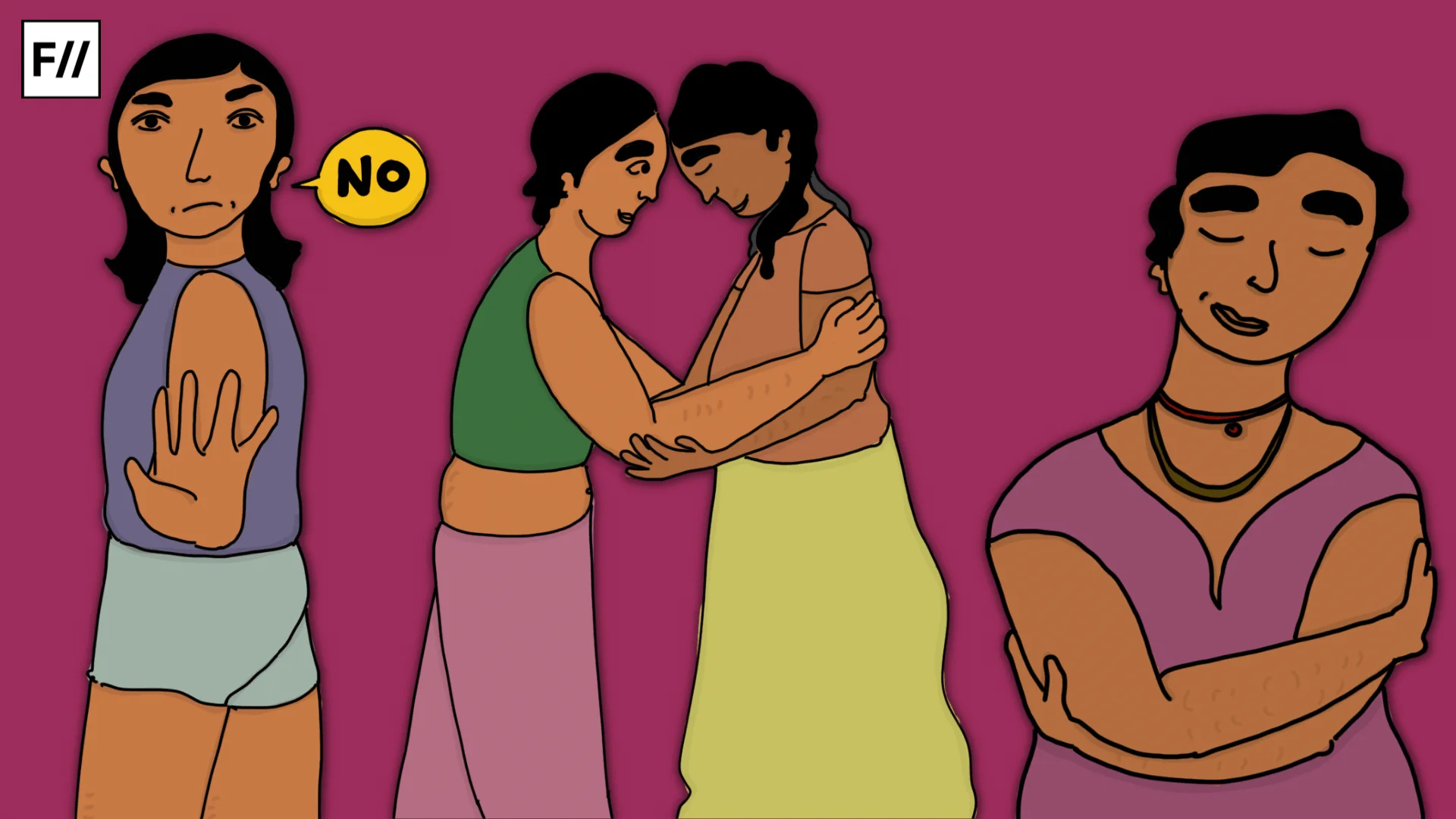Vaginismus is medically defined as, “The persistent or recurrent difficulties of the women to allow the vaginal entry of penis, a finger or any object, despite the women’s wish to do so.” This could be followed with, “involuntary pelvic muscle contraction, anticipate fear or experience pain.” It is a categorized as clinical syndrome without a definitive diagnosis.
I was worried about my own vagina. It needed a context of other vaginas—a community, a culture of vaginas. There’s so much darkness and secrecy surrounding them—like the Bermunda Triangle.
– Eve Ensler, The Vagina Monologues
The society that we live in, and societies that we are surrounded with, have always remained silent when questioned about female sexuality. This is a topic which has been swept aside without paying attention, since the time one could account for. Female sexuality has only been approved when spoken along the lines of ‘reproduction’ and otherwise, talking about female sexuality independently is still in many cultures considered a taboo; something that one must not talk or discuss about.
The cost of not acknowledging female sexuality could be traced through the ignorance shown towards women’s bodies. Most of the women are not aware of female orgasms, and dismiss the idea of pleasuring oneself. Even in the early West, Hippocrates discarded anything related to female sexuality branding it as ‘melancholy madness’ and recommended ‘marriage’ as the cure to problems of these kinds.
The sociological understanding of female sexualities have been classified into two binaries: Madonna-Whore. The woman who does not speak or express her sexuality, and is docile is an idealised version of womanhood. This archetype is compared with Madonna, who is known for her ‘meek, faithfulness’ towards her spouse. As opposed to women who are fierce, strong headed and open about what they want. These are the women one must be ‘careful’ with. They are understood as ‘characterless whores’ who would sleep with anyone.

The only explanation that was associated with female sexuality was that of ‘hysteria’. It was theorised by the seventeenth century French physician Jacques Ferrand that, lovesickness affects women because they are “less rational, more maniacal in their love.” It is essential to understand the conditions of women in the society concerning their sexualities. In the period of colonisation, evangelisation was a widespread phenomenon and through this religious upheaval, the British made sure to ‘sanitise’ everything which they felt was ‘improper’. Along with several other ideals, the idealisation of women being passive and silent was planted in the minds of people.
Due to the constant construction and re-construction of moralities in societies, issues that are personal to us and which demand to be discussed have been marginalised. Many women have a problem with intercourse, and some find it unfathomable to take part in coitus.
Also read: The History Of ‘Hysteria’ And How Science Can Be Sexist
The cause of vaginismus is inconclusive but through interviews it is found that women suffering from vaginismus generally come from families which are very “regressive in terms of their believes about sex.” Anecdotal references also suggest that “aversive sexual experiences are important in the development of vaginismus.”
A friend of mine who wishes to be anonymous said that, for a long time she did not understand what sex meant. She thought that she would ‘figure it out’ after she gets married. But when she got involved in a romantic relationship with a man, it became necessary to understand what was happening to her. Despite several attempts, she could not bring herself to have penetrative sex. She said, “I used to live in a constant fear of my boyfriend cheating on me. I hear everyone talk about sex and how pleasurable it is. I feel pleasure when he touches me, but the moment he tries to insert anything, I break into cold sweat.”
When asked if she has spoken about this to her family, she replied, “I did and my mother said that it is a good thing that you are unable to do anything now. Once you get married, everything will be fine.“
I was always told that sex was supposed to be painful for the first few times and will reduce slowly. I never knew that there is something called vaginismus, even though it’s a really common issue.
In a society like ours that is uncomfortable with discussing sexuality, it becomes all the more difficult to discuss about problems related to penetrative sex. For so many women, sex is associated with pain than pleasure and it comes with a moral obligation to fulfill this duty without expressing dissent of any kind. Women have been made strangers to their own bodies and this later affects them emotionally and mentally.
When asked about vaginismus to my colleague she said, “I was always told that sex was supposed to be painful for the first few times and will reduce slowly. I never knew that there is something called vaginismus, even though it’s a really common issue.” She further added that it affected her both emotionally and mentally before she decided to take help.
Her experiences with conservative doctors have been really hard. “One of them was extremely judgmental. Three of them told me ‘you just need to relax’.”
She said, “Umm.. I will relax when it doesn’t feel like someone is cutting me down there with a sharp glass, you know? They never even mentioned the term vaginismus.” However she added, “That was until I met my therapist. A good therapist can do wonders.”
In a patriarchal society, penetrative sex is considered as the only kind of sex which is acceptable. Like Luce Irigaray said, “Female sexuality has always been conceptualised on the basis of masculine parameters.” Female eroticism involves more than just penetration and there are multiple ways through which women could achieve orgasms. The regressive idea that limits her ‘pleasure’ to vaginal penetration becomes a way through which patriarchy imposes heterosexuality in the society. The inability of having penetrative sex is hence, blamed on women for not being ‘woman’ enough to oblige her heterosexual partner.
Also read: Of Vaginas, Virginity and the Two-Finger Test
Having said that, vaginismus could be treated clinically through therapy and there have been several positive results from people who have taken clinical support to overcome the fear of penetration. Vaginismus Support is an online support group that connects people facing similar problems. There are several other groups that support women to deal with Vaginismus.
It is however, always important to keep in mind that vaginismus is a common occurrence among women and it should always be seen as any other ailment that a body goes through, instead of degrading women for not being able to cater to the heteronormative model of sex.

My colleague after having taken help said, “To know that there are people who are going through the same thing as you are, can help a lot. My support group has been my go to place whenever I am feeling down. These people are extremely kind, supportive and helpful. I have learned a lot about the treatment process too.”
The binaries that function in the society creates stigma against women for not being able to satisfy men. But in reality, women have different ways through which she could pleasure herself, and her sexuality like Irigaray writes, “is plural.” It is time for us to come together and break the notions of single sex that commodifies the idea of ‘love-making.’ After all, we need to remember and constantly reinstate, “The sex which is not one.”
Also read: Dear People, Here’s Why You Need To Leave Your Vaginas Alone
References
- Vaginismus: Its Management And Psychogenesis by Joan Malleson
- Nymphomania: The Historical Construction of Female Sexuality by Carol Groneman
- The Sex Which is Not One by Luce Irigaray
Featured Image Source: Metro
About the author(s)
Divya Krishnamoorthy loves listening to stories and believes that we are all stories who stay alive only through narration. She is a Masters student in English at Ambedkar University, Delhi. When she is not writing her papers, you will definitely find her having one of her weird reveries.




